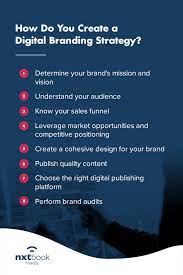The Importance of Brand Development in Today’s Competitive Market
In today’s fast-paced and competitive market, brand development plays a crucial role in the success of any business. Your brand is much more than just a logo or a catchy slogan – it is the essence of your company, encapsulating its values, personality, and unique selling points. Effective brand development can help you stand out from the crowd, build customer loyalty, and drive long-term growth.
Building Trust and Credibility
A strong and consistent brand identity helps to build trust and credibility with your target audience. When customers can easily recognise and connect with your brand, they are more likely to choose your products or services over competitors. By establishing a positive reputation through branding, you can create a loyal customer base that keeps coming back for more.
Differentiation in a Crowded Marketplace
With so many businesses vying for consumers’ attention, it is essential to differentiate yourself from the competition. Effective brand development allows you to carve out a unique position in the market, highlighting what sets you apart from others. By clearly communicating your brand’s values and benefits, you can attract the right audience and make a lasting impression.
Driving Business Growth
A well-developed brand can be a powerful driver of business growth. When customers have a positive perception of your brand, they are more likely to recommend it to others and become repeat buyers. This word-of-mouth marketing can lead to increased sales and expanded market reach, helping your business thrive in an increasingly competitive landscape.
Consistency Across Channels
Consistency is key when it comes to brand development. Your branding should be cohesive across all channels – from your website and social media profiles to your packaging and advertising materials. A unified brand image helps to reinforce your messaging and create a memorable experience for customers at every touchpoint.
In conclusion, investing in brand development is essential for any business looking to succeed in today’s competitive market. By building a strong brand identity that resonates with your target audience, you can differentiate yourself from competitors, drive customer loyalty, and ultimately achieve sustainable growth.
Understanding Brand Development: Key Questions and Strategies Uncovered
- What are the four stages of brand development?
- What are the 4 steps of branding?
- What are the 7 steps in the brand development process?
- What are the 4 brand development strategies?
- What is the process of developing a brand?
- What are the 3 C’s of brand development?
- What are the 5 strategies in brand development?
What are the four stages of brand development?
Brand development typically consists of four key stages: brand awareness, brand recognition, brand trial, and brand loyalty. In the initial stage of brand development, building brand awareness is crucial to ensure that consumers recognise and remember your brand. This is followed by brand recognition, where customers can identify your brand among competitors. The next stage involves encouraging customers to try your products or services, known as brand trial. Finally, the ultimate goal of brand development is to foster strong brand loyalty among customers, where they consistently choose your brand over others and become advocates for your products or services. These four stages are essential for creating a successful and sustainable brand in today’s competitive market.
What are the 4 steps of branding?
When it comes to brand development, understanding the essential steps is key to creating a successful and impactful brand identity. The four fundamental steps of branding typically involve brand strategy, brand positioning, brand identity design, and brand communication. These steps encompass defining your brand’s purpose and values, identifying your target audience, creating a visual identity that reflects your brand personality, and effectively communicating your brand message across various channels. By following these strategic steps, businesses can establish a strong and memorable brand that resonates with their customers and sets them apart in the competitive market.
What are the 7 steps in the brand development process?
In the brand development process, there are typically seven key steps that businesses follow to create a strong and impactful brand identity. These steps include defining your brand strategy, conducting market research to understand your target audience, creating a unique brand positioning, developing your brand messaging and visuals, implementing your branding across various touchpoints, monitoring and measuring the effectiveness of your branding efforts, and finally, refining and evolving your brand as needed to stay relevant and competitive in the market. By following these seven steps diligently, businesses can establish a compelling brand that resonates with customers and drives long-term success.
What are the 4 brand development strategies?
When it comes to brand development, there are four key strategies that businesses often employ to strengthen their brand identity and connect with their target audience. The first strategy is differentiation, where a brand distinguishes itself from competitors by highlighting its unique selling points and values. Consistency is another vital strategy, ensuring that the brand message and visual identity remain uniform across all touchpoints. Brand extension involves leveraging an existing brand to introduce new products or services, while brand repositioning focuses on altering perceptions to appeal to a different market segment. By carefully implementing these four brand development strategies, businesses can enhance their market presence and foster long-term customer loyalty.
What is the process of developing a brand?
Developing a brand involves a strategic process that encompasses various key steps to establish a strong and recognisable brand identity. The process typically begins with conducting thorough market research to understand the target audience, competitors, and industry trends. This is followed by defining the brand’s mission, values, and unique selling proposition to differentiate it in the market. Next, creating visual elements such as logo, colour palette, and typography helps in crafting a cohesive brand image. Consistency is crucial across all touchpoints, including marketing materials, website design, and customer interactions. Finally, ongoing brand monitoring and adaptation ensure that the brand remains relevant and resonates with its audience over time.
What are the 3 C’s of brand development?
When it comes to brand development, the concept of the 3 C’s plays a significant role in shaping a brand’s identity and success. The 3 C’s of brand development typically refer to Clarity, Consistency, and Constancy. Clarity involves ensuring that your brand message is clear and easily understood by your target audience. Consistency emphasises the importance of maintaining a uniform brand image across all touchpoints to build trust and recognition. Constancy highlights the need for continuous efforts in reinforcing your brand values and staying relevant in the ever-evolving market landscape. By focusing on these 3 C’s, businesses can effectively establish a strong and memorable brand that resonates with customers and drives long-term growth.
What are the 5 strategies in brand development?
When it comes to brand development, there are five key strategies that businesses can implement to strengthen their brand identity and enhance their market presence. These strategies include defining a clear brand purpose and positioning that sets them apart from competitors, creating a consistent visual identity through logo design and branding elements, establishing strong brand messaging that resonates with their target audience, building brand awareness through effective marketing and communication channels, and fostering customer loyalty by delivering exceptional products or services that align with their brand values. By incorporating these strategies into their brand development efforts, businesses can establish a strong and memorable brand that drives success in today’s competitive market.



